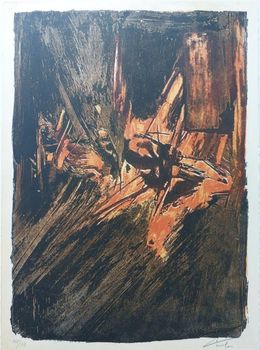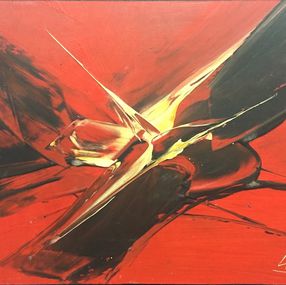
Presentation
José Viola Gamón (Zaragoza, May 18, 1916 - San Lorenzo de El Escorial, Madrid, March 8, 1987), known by the pseudonym of Manuel Viola (a name he adopted after the Spanish Civil War) Poet and Spanish painter of abstract style belonging to the group El Paso, whose race was developed mainly in Aragon. His painting is characterized by an informalist and colorist treatment in the line of avant-gardes that developed in Spain from the 1950s. In 1936 he was part of the Logicofobist Group and contributed to drafting his manifesto defending surrealism in the service of the revolution .
Signature of Manuel Viola
Contents [hide]
1 Biography
2 Awards and decorations
3 References
4 External links
Biography [edit]
Viola had an autodidact education, although it began university studies of Philosophy and Letters in Barcelona, ??that were truncated with the beginning of the civil war. From these years his first drawings and his beginnings in the field of literature and art date, because he is cofounder in Lérida of the surrealist magazine Art.
Together with such companies as Lorca, J. V. Foix, Alberti or Cocteau, Viola published poems of clear super-royalist ascendancy: "the red wine of the air curls / in a naked horse skeleton" 1
In 1936 he formed part of the ADLAN group (Friends of the New Arts) in Barcelona and in May of the same year he wrote with the art critic Magí Albert Cassanyes the manifesto of the Legicofobista Exhibition. 2 Viola related the exhibition to surrealism, and pointed out that this movement was a kind of subset of logophobeism. In his view, poetry was the portal that would lead artists to a new form of knowledge.3
Of an anarchist spirit, 1 in the civil war joined militant ranks of the Workers' Party of Marxist Unification (POUM) in defense of the Republic. After the war, he had to go into exile in France, living the ordeal of concentration camps on the French beaches.1 In France he continued to fight against the Axis side, linked to the painters and poets of the superrealist group, and collaborated in the magazine La main To the plume of surrealist poetry. His activity in Paris also began his participation as a painter in the exhibitions of the «Spanish School of Paris», until he returned to Spain in 1949, although he would never cease to have contact with the group of Spanish artists of the Gallic capital .
The year 1958 marks the beginning of his personal style, while being integrated into the group of avant-garde painter El Paso, which included, among others, the painter Antonio Saura and the sculptor Pablo Serrano, both Aragonese. He began to develop an abundant expressionist painting and a great concern for color. Up to that point, the figurative references and allusion to the landscape prevailed, as shown in his work Pelea de gallos.
However, since its ascription to the group El Paso in the late fifties, his painting operates from energetic visual forms generated from a central mass. It fundamentally works the chromatic and light aspects from the abstract geometrization and without leaving aside the work in the textures and a vague cosmic character. His palette and ways remember, in any case, Spanish Baroque painting, the great cultural and artistic reference of his paintings.
In the early years of his 1958 style change, his painting dispenses with color, and basically works from whites and blacks, with a wide intermediate range of grays and some land of great effect. Later it will evolve towards a much wider range where warm colors dominate and the contrast with brush strokes of green and blue tones.
In 1972 he returned to Lérida where he presented his first exhibition in the Hall Gosè of the College of Architects of the city after years of absence and later in the Lonja de Zaragoza. In the same year he also exhibited at Sala Gaudí Barcelona, ??4 which now has a part of his work.5 In 1983 he made a second exhibition at Alfós Gallery, with 45 pieces chosen by him, including a key painting in his work: Window to Death ". Among his anthological samples, it is possible to emphasize the one that offered in Madrid the Museum of Contemporary Art.
He died after suffering lung cancer for a long time on March 8, 1987 in El Escorial, where he had lived since 1961.1 He was buried in the cemetery of this town.
His work is, among others, in the Reina Sofía Museum in Madrid, the Museum of Abstract Art in Cuenca, the Museum of Contemporary Art in Elche, the Guggenheim in New York, the Museum of Modern Art in Liege or the National Museum of Buenos Aires.
Read more
Signature of Manuel Viola
Contents [hide]
1 Biography
2 Awards and decorations
3 References
4 External links
Biography [edit]
Viola had an autodidact education, although it began university studies of Philosophy and Letters in Barcelona, ??that were truncated with the beginning of the civil war. From these years his first drawings and his beginnings in the field of literature and art date, because he is cofounder in Lérida of the surrealist magazine Art.
Together with such companies as Lorca, J. V. Foix, Alberti or Cocteau, Viola published poems of clear super-royalist ascendancy: "the red wine of the air curls / in a naked horse skeleton" 1
In 1936 he formed part of the ADLAN group (Friends of the New Arts) in Barcelona and in May of the same year he wrote with the art critic Magí Albert Cassanyes the manifesto of the Legicofobista Exhibition. 2 Viola related the exhibition to surrealism, and pointed out that this movement was a kind of subset of logophobeism. In his view, poetry was the portal that would lead artists to a new form of knowledge.3
Of an anarchist spirit, 1 in the civil war joined militant ranks of the Workers' Party of Marxist Unification (POUM) in defense of the Republic. After the war, he had to go into exile in France, living the ordeal of concentration camps on the French beaches.1 In France he continued to fight against the Axis side, linked to the painters and poets of the superrealist group, and collaborated in the magazine La main To the plume of surrealist poetry. His activity in Paris also began his participation as a painter in the exhibitions of the «Spanish School of Paris», until he returned to Spain in 1949, although he would never cease to have contact with the group of Spanish artists of the Gallic capital .
The year 1958 marks the beginning of his personal style, while being integrated into the group of avant-garde painter El Paso, which included, among others, the painter Antonio Saura and the sculptor Pablo Serrano, both Aragonese. He began to develop an abundant expressionist painting and a great concern for color. Up to that point, the figurative references and allusion to the landscape prevailed, as shown in his work Pelea de gallos.
However, since its ascription to the group El Paso in the late fifties, his painting operates from energetic visual forms generated from a central mass. It fundamentally works the chromatic and light aspects from the abstract geometrization and without leaving aside the work in the textures and a vague cosmic character. His palette and ways remember, in any case, Spanish Baroque painting, the great cultural and artistic reference of his paintings.
In the early years of his 1958 style change, his painting dispenses with color, and basically works from whites and blacks, with a wide intermediate range of grays and some land of great effect. Later it will evolve towards a much wider range where warm colors dominate and the contrast with brush strokes of green and blue tones.
In 1972 he returned to Lérida where he presented his first exhibition in the Hall Gosè of the College of Architects of the city after years of absence and later in the Lonja de Zaragoza. In the same year he also exhibited at Sala Gaudí Barcelona, ??4 which now has a part of his work.5 In 1983 he made a second exhibition at Alfós Gallery, with 45 pieces chosen by him, including a key painting in his work: Window to Death ". Among his anthological samples, it is possible to emphasize the one that offered in Madrid the Museum of Contemporary Art.
He died after suffering lung cancer for a long time on March 8, 1987 in El Escorial, where he had lived since 1961.1 He was buried in the cemetery of this town.
His work is, among others, in the Reina Sofía Museum in Madrid, the Museum of Abstract Art in Cuenca, the Museum of Contemporary Art in Elche, the Guggenheim in New York, the Museum of Modern Art in Liege or the National Museum of Buenos Aires.
All artworks of Manuel Viola

Discover our selections of works by artists
Need help finding your favorite? Consult our selection pages made for you.
Need to know more?
What are their 3 main works?
When was Manuel Viola born?
The year of birth of the artist is: 1916
